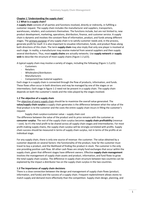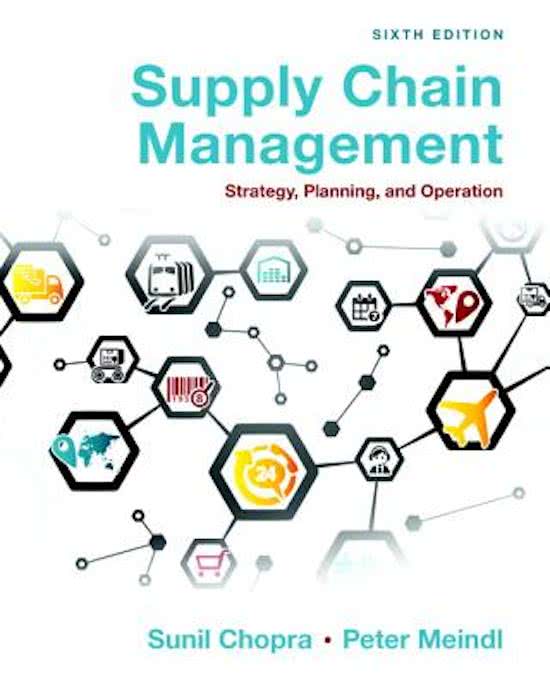Summary Supply Chain Management
Chapter 1 ‘Understanding the supply chain’
1.1 What is a supply chain?
A supply chain consists of all parties and functions involved, directly or indirectly, in fulfilling a
customer request. The supply chain includes the manufacturer and suppliers, transporters,
warehouses, retailers, and customers themselves. The functions include, but are not limited to, new
product development, marketing, operations, distribution, finance, and customer service. A supply
chain is dynamic and involves the constant flow of information, product, and funds among different
stages. The primary purpose of any supply chain is to satisfy customer needs and, in the process,
generate profit for itself. It is also important to visualize information, funds, and product flows along
both directions of this chain. The term supply chain may also imply that only one player is involved at
each stage. In reality, a manufacturer may receive material from several suppliers and then supply
several distributors. Thus, most supply chains are actually networks. Use supply network or supply
web to describe the structure of most supply chains (Figure 1-2 p15).
A typical supply chain may involve a variety of stages, including the following (Figure 1-2 p15):
- Customers
- Retailers
- Wholesalers/distributors
- Manufacturers
- Component/raw material suppliers
Each stage in a supply chain is connected through the flow of products, information, and funds.
These flows often occur in both directions and may be managed by one of the stages or an
intermediary. Each stage in figure 1-2 need not be present in a supply chain. The supply chain
depends on both the customer’s needs and the roles played by the stages involved.
1.2 The objective of a supply chain
The objective of every supply chain should be to maximize the overall value generated. The
value/supply chain surplus a supply chain generates is the difference between what the value of the
final product is to the customer and the costs the entire supply chain incurs in filling the customer’s
request:
Supply chain surplus=customer value – supply chain cost
The difference between the value of the product and its price remains with the customer as
consumer surplus. The rest of the supply chain surplus becomes supply chain profitability (revenue
– cost). So it’s the total profit to be shared across all supply chain stages and intermediaries. For most
profit-making supply chains, the supply chain surplus will be strongly correlated with profits. Supply
chain success should be measured in terms of supply chain surplus, not in terms of the profits at an
individual stage.
For any supply chain, there is only one source of revenue: the customer. The value obtained by a
customer depends on several factors: the functionality of the product, how far the customer must
travel to buy a product, and the likelihood of finding the product in stock. The customer is the only
one providing positive cash flow. All other cash flows are simply fund exchanges that occur within the
supply chain, given that different stages have different owners. Effective supply chain management
involves the management of supply chain assets and product, information, and fund flows to grow
the total supply chain surplus. The difference in supply chain structure between two countries can be
explained by the impact a distributor has on the supply chain surplus in the two countries.
1.3 The importance of supply chain decisions
There is a close connection between the design and management of supply chain flows (product,
information, and funds) and the success of a supply chain. Frequent replenishment allows stores to
match supply and demand more effectively than the competition. Supply chain design, planning, and
1
, Summary Supply Chain Management
operation decisions play a significant role in the success or failure of a firm. To stay competitive,
supply chains must adapt to changing technology and customer expectations
1.4 Decision phases in a supply chain
There are decisions which fall into three categories or phases, depending on the frequency of each
decision and the time frame during which a decision phase has an impact. As a result, each category
of decisions must consider uncertainty over the decision horizon.
1. Supply chain strategy or design: During this phase, a company decides how to structure the
supply chain over the next several years. It decides what the chain’s configuration will be,
how resources will be allocated, and what processes each stage will perform. Strategic
decisions made by companies include whether to outsource or perform a supply chain
function in-house, the location and capacities of production and warehousing facilities, the
products to be manufactured or stored at various locations, the modes of transportation to
be made available along different shipping legs, and the type of information system to be
used. Supply chain design decisions are typically made for the long term (a matter of years)
and are expensive to alter on short notice. Consequently, when companies make these
decisions, they must take into account uncertainty in anticipated market conditions over the
following few years.
2. Supply chain planning: For decisions made during this phase, the time frame considered is a
quarter to a year. Therefore, the supply chain’s configuration determined in the strategic
phase is fixed. This configuration establishes constraints within which planning must be
done. The goal of planning is to maximize the supply chain surplus that can be generated
over the planning horizon given the constraints established during the strategic or design
phase. Planning includes making decisions regarding which markets will be supplied from
which locations, the subcontracting of manufacturing, the inventory policies to be followed,
and the timing and size of marketing and price promotions. In the planning phase, companies
must include uncertainty in demand, exchange rates, and competition over this time horizon
in their decisions. Companies in the planning phase try to incorporate any flexibility built into
the supply chain in the design phase and exploit it to optimize performance. As a result of
the planning phase, companies define a set of operating policies that govern short-term
operations.
3. Supply chain operation: The time horizon here is weekly or daily. Companies make decisions
regarding individual customer orders. At the operational level, supply chain configuration is
considered fixed and planning policies are already defined. The goal of supply chain
operations is to handle incoming customer orders in the best possible manner. Firms allocate
inventory or production to individual orders, set a date by which an order is to be filled,
generate pick lists at a warehouse, etc. Because operational decisions are being made in the
short term, there is less uncertainty about demand information. Given the constraint
established by the configuration and planning policies, the goal during the operation phase is
to exploit the reduction of uncertainty and optimize performance.
1.5 Process views of a supply chain
There are two ways to view the processes performed in a supply chain:
1. Cycle view: The processes in a supply chain are divided into a series of cycles, each
performed at the interface between two successive stages of the supply chain.
2. Push/pull view: The processes in a supply chain are divided into two categories. Pull
processes are initiated by a customer order, whereas push processes are initiated and
performed in anticipation of customer orders.
Cycle view of supply chain processes
Given the five stages of a supply chain (figure 1-2), all supply chain processes can be broken down
into four process cycles, as shown in figure 1-3 p20:
2
, Summary Supply Chain Management
- Customer order cycle
- Replenishment cycle
- Manufacturing cycle
- Procurement cycle
Each cycle occurs at the interface between two successive stages of the supply chain. Not every
supply chain will have all four cycles clearly separated. Each cycle consists of six subprocesses:
The subprocesses in this figure can be linked to the source, make, deliver, and return processes in the
supply chain operations references (SCOR) model. The SCOR model provides a description of supply
chain processes, a framework for relationship between these processes, and a set of metrics to
measure process performance. The description of the supply chain in the SCOR model is similar to
the cycle view of supply chains.
Within each cycle, the goal of the buyer is to ensure product availability and to achieve economies of
scale in ordering. Even though each cycle has the same basic subprocesses, there are a few important
differences among the cycles. In the customer cycle, demand is external to the supply chain and thus
is uncertain. In all other cycles, order placement is uncertain but can be projected based on policies
followed by the particular supply chain stage. The second difference across the cycles relates to the
scale of an order. As we move from the customer to the supplier, the number of individual orders
declines and the size of each order increases. Sharing of information and operating policies across
supply chain stages becomes more important as we move further from the end customer.
The detailed process description of a supply chain in the cycle view is useful when considering
operational decisions because it clearly specifies the roles of each member of the supply chain. The
cycle view is used by enterprise resource planning (ERP) systems to support supply chain operations.
Push/pull view of supply chain processes
With pull processes, execution is initiated in response to a customer order. Pull processes may also
be referred to as reactive processes because they react to customer (certain) demand. With push
processes, execution is initiated in anticipation of customer orders based on a forecast. Push
processes may also be referred to as speculative processes because they respond to
speculated/forecasted (uncertain) demand. The push/pull boundary in a supply chain separates
push processes from pull processes (figure 1-5 p22). The push/pull processes are often constrained
by inventory and capacity decisions that were made in the push phase. This view is useful when
considering strategic decisions relating to supply chain design. The goal is to identify an appropriate
push/pull boundary such that the supply chain can match supply and demand effectively.
Examples: figure 1-6 and figure 1-7 p23, including text.
Supply chain macro processes in a firm
All supply chain processes discussed in the two process views can be classified into the following
three macro processes (figure 1-8 p24):
3
, Summary Supply Chain Management
1. Customer relationship management (CRM): All processes at the interface between the firm
and its customers. It aims to generate customer demand and facilitate the placement and
tracking of orders. It includes processes such as:
a. Marketing
b. Pricing
c. Sales
d. Orders management
e. Call center management
2. Internal supply chain management (ISCM): All processes that are internal to the firm. It aims
to fulfill demand generated by the CRM process in a timely manner and at the lowest
possible costs. It includes processes such as:
a. Strategic planning (planning of internal production and storage capacity)
b. Demand planning
c. Supply planning
d. Fulfillment of actual orders
e. Field service
3. Supplier relationship management (SRM): All processes at the interface between the firm
and its suppliers. It aims to arrange for and manage supply sources for various goods and
services. It includes processes such as:
a. Source (evaluation and selection of suppliers)
b. Negotiation of supply terms
c. Buy
d. Design collaboration
e. Supply collaboration
These three macro processes manage the flow of information, product, and funds required to
generate, receive and fulfill a customer request.
Key point: Integration among the three macro processes is crucial for successful supply chain
management. It is not unusual for marketing and manufacturing to have different forecasts when
making their plans. This lack of integration hurts the supply chain’s ability to match supply and
demand effectively, leading to dissatisfied customers and high costs. Thus, firms should structure a
supply chain organization that mirrors the macro processes and ensures good communication and
coordination among the owners of processes that interact with one another.
1.6 Examples of supply chains
1.7 Summary of learning objectives
4






